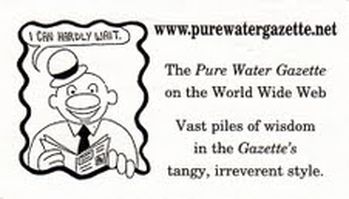Special Mid-Month Issue October 15, 2012 |
|---|
We hope you'll read the Pure Water Gazette's new "Today's Top Water News" section. New articles appear daily. Some examples of recent posts are included in his issue. |
In the News
Jackson, Mississippi Busted by EPA For Dumping Barely Treated Sewage into the Pearl River
The Jackson City Council in Mississippi approved a consent decree with the Environmental Protection Agency (EPA) to spend around $400 million to rebuild its sewage system over the coming years and to pay a fine.
The EPA has been negotiating the decree with the city of Jackson, Miss. for two years, the local newspaper reported.
The city was allegedly bypassing sewage treatment at its Savannah Street plant, dumping much of it into the Pearl River with only rudimentary chlorine treatment.
The Mississippi Department of Environmental Quality fined the city $240,000 in 2010 for similar violations.
“Let me just say that this has happened all across the country,” Mayor Harvey Johnson Jr. said after the meeting. “We’re not in this boat alone, but we’re very pleased that our negotiating team was able to craft this deal. We were talking about much more money, initially, and less time to fix the problem.”
The council decision came after a hotly contested 3-2 vote, with one councilman complaining that no agreement should have been reached before a decision on how the money to pay for the improvements could be raised. He seemed to argue that raising taxes or water rates was not acceptable.
The decree will commit the city to replacing crumbling sewer lines and faulty treatment equipment that state and city officials say have been in need of upgrades for years.
Mayor Johnson is correct that similar situations are occurring “all across the country,” as infrastructures age and the “no new taxes” viewpoint persists.
Read the entire article here.
Scummy Baptistery in Texas Church Cleaned Up by an Alternative Softener
After years of enduring the embarrassment of leading converts into a baptismal pool stained with unsightly spots and hardness scaling, pastor Elroy Townsend of the Church of Christ of Spinner, Texas convinced the budget committee to provide funds for an electronic scale-prevention system for the church’s baptistery.
The result has been spectacular. Townsend said that within a few days of installation of the new system, ugly hard water residue began to disappear. “It was like a miracle,” the pastor exclaimed.
Spinner’s water supply, which comes from deep wells, is extremely hard. “Almost hard enough to walk on,” Townsend said, then he quickly added, “Just joking.”
Other area churches have tried a variety of solutions to the hard water dilemma. The First Baptist, with the town’s largest congregation, has for years used a conventional water softener provided free by a local water treatment dealer whose colorful logo can be seen at the back of the baptismal pool. A small Methodist congregation in Spinner even filled its baptistery with bottled reverse osmosis water for a time, but has since abandoned the practice because of the expense.
“I looked at both these options before deciding on the descaler,” Townsend said, “but people really don’t like the slick feel of conventionally softened water, and the bottled reverse osmosis water has the natural minerals removed. We feel that baptism just isn’t the same unless the water used has its full complement a natural minerals.”
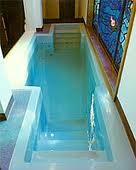 |
|---|
| Spinner's Scale-Free Baptismal Pool |
More about scale prevention in baptismal pools.
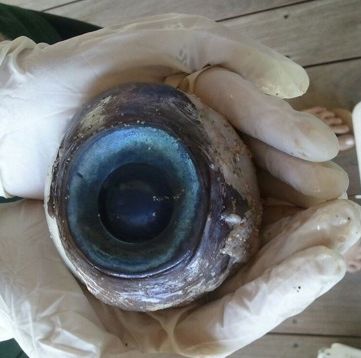 |
|---|
| Softball-Sized Eyeball of an Unknown Creature that Appeared on a Florida Beach. For more details, plus a picture of a scary oarfish that surfaced on a Mexican beach earlier this month, read the Pure Water Gazette account. |
Installing Undersink Water Filters and Reverse Osmosis Units
by Gene Franks
Editor's Note: This is a pretty humdrum presentation of a really exciting topic. Try to read it with the enthusiasm that the author failed to communicate.--Hardly Waite.
Although there are "simple" undersink filters that deliver filtered water through the regular sink faucet, the most common installation is with a "dedicated faucet," a separate spigot that handles only the treated water. This discussion is about the "dedicated faucet" style installation only.
Undersink filters and reverse osmosis units are installed in the same way. There are just a couple of simple extra steps needed for reverse osmosis.
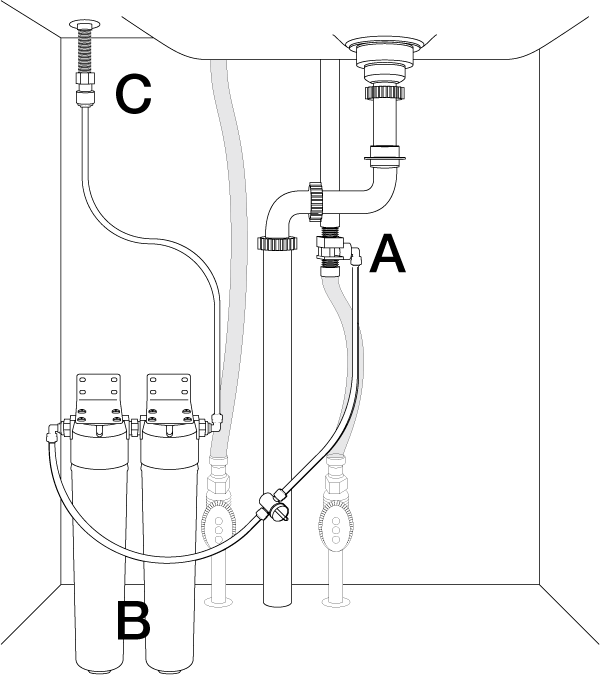 |
|---|
Basic Undersink Filter Installation. A: The Inlet Adapter. B: The Filtration Unit. C: The Faucet Connection. |
Undersink Filters
With an undersink filter, the installation involves getting a source of water, which is usually from the tube or pipe that carries cold tap water up to the sink faucet, routing the tap water supply through the filter, then sending the filtered water to the filter's own dedicated spigot that is mounted on the sink top. There may be a hole in the sink that you can use for the spigot, but usually a new hole has to be drilled.
The filter itself can usually be wall mounted with screws, although most filters can stand alone without wall mounting or even lie on their back.
Installing undersink filters has gotten simpler in recent years because of the almost universal use of flexible undersink piping. Most modern undersink filters are supplied with an inlet adapter that allows easy access to a water source. In the picture, the adapter A was installed by removing the top end of the flexible connector, screwing the adapter to the threaded stem of the sink faucet, then screwing the flexible pipe to the bottom of the adapter. The connection could also be made at the bottom end of the tube. Almost all upper connections are now 1/2" and most bottom connections are 3/8". The inlet tube of the filter is usually 1/4" polyethylene.
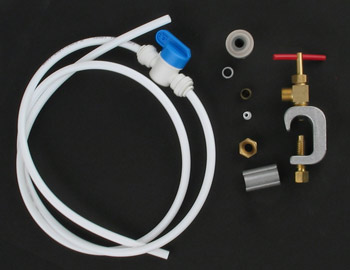 |
|---|
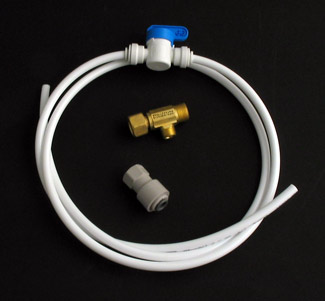 |
| Inlet Adapter Kits. Top picture shows the old standard self-piercing "saddle valve" used to install on hard copper pipes. Saddle valves are seldom used now because of the almost universal use of flexible piping for undersink faucets. The bottom picture shows a 3/8" adapter system sized to install on the bottom end of most cold water flexible pipes. |
The picture below shows the 3/8" adapter installed on the bottom end of the 3.8" flexible inlet tube:
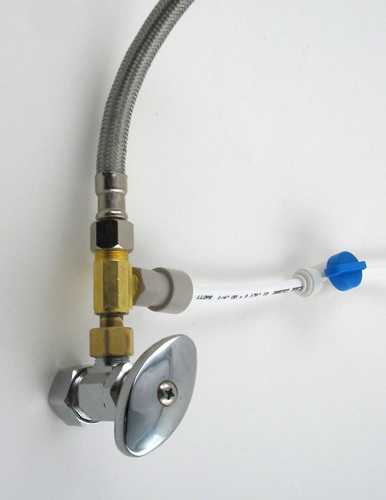 |
|---|
| Superb, Leak-Free Inlets like the "Max Adapter" above make undersink installation very easy. |
Installation to the filter itself is most often with push-in quick connect fittings. This change alone makes undersink filters and reverse osmosis units much easier and faster to install.
Faucet installation involves first of all, getting a hole in the sink. Some countertops, like granite, should be drilled only by a professional who has the proper tools, but most handymen and homeowners can drill their own hole in stainless steel sinks and sinks made of other light materials. For the simple spigots normally used with filters, like the one in the picture, the hole needs to be 7/16" or slightly larger. This is a case where bigger is not better. It's hard to install most ledge faucets on a 1.5" hole.
Tube-attached faucets--faucets in which the manufacturer has installed the tubing at the factory--make installation much easier. With a standard (non-tube-attached) faucet, the installer can use a standard compression fitting, or, much simpler, one of the very handy quick-connect faucet/refrigerator connectors. These make installation easy even in the tightest places. A faucet connector is used in top picture. It is hand-tightened onto the faucet stem, then the tube is poked into the quick-connect fitting. (The faucet connector can also be used with 1/4" compression inlets and connections at the back of refrigerators.)
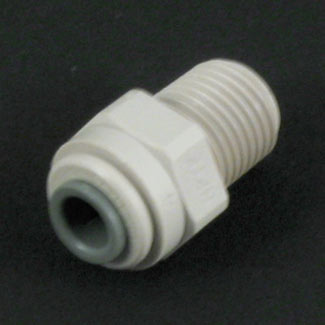 |
|---|
| Most undersink reverse osmosis units and filters now use quick-connect fittings. They make installation easy. Just push in the tube. |
Undersink Reverse Osmosis
Installing a reverse osmosis unit involves the steps shown above with the filter--establishing an inlet, then sending the treated water to a sink-mounted faucet--plus two more relatively easy steps.
One is simply connecting the main body of the RO unit to its storage tank. The tank is connected to the RO unit with a single tube. Water goes into the tank and leaves the tank through a valve at the top of the tank. Just plug the unit's tank tube into the fitting in the valve at the top of the tank.
Finally, the RO unit's brine tube, where reject water leaves the unit, is connected to an undersink drain. In "air gap" units the connection is a bit more complicated. If an air-gap faucet is used, the 1/4" brine tube from the RO unit connects to a barbed connector at the base of the ledge faucet, then a 3/8" tube is connected to to the base of the faucet to carry the brine to the drain pipe. In non-air gap units, the 1/4" brine tube connects directly to the drain pipe. In both cases, connection to the drain pipe is made by drilling a small hole--1/4" is the usual--into the drain pipe then attaching a special part called a drain saddle to the pipe to hold the tube in place so that the trickle of drain water can enter the drain pipe through the hole.
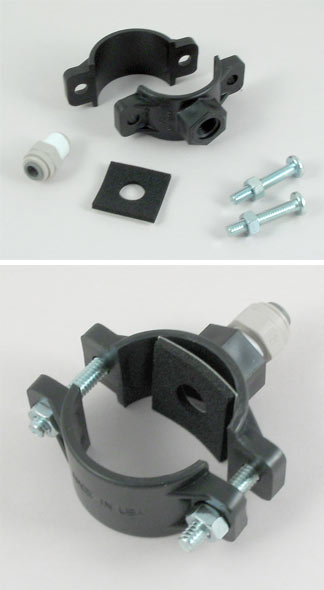 |
|---|
Drain Saddle Assembly The assembly is installed over a 1/4" hole in the drain pipe. The brine tube from the RO unit is pushed into the quick-connect fitting. |
Full instructions for Installation of Pure Water Products Black and White Undersink Filters.
Full instructions for Installation of Pure Water Products Black and White Reverse Osmosis Unit.
ZZZZZZZZZZZZZZZZZZZZZZZZ--Hardly Waite.
Removing "Pharmaceuticals" from Water: “Expecting a Water Filter to Remove All ‘Pharmaceuticals’ Is Like Expecting a Pill to Contain All Nutrients”
One of the most perplexing questions that water treatment dealers get is, “Do you have a product that will take the pharmaceuticals out of water?” Clearly, there is no simple answer to the question because “pharmaceuticals” includes literally thousands of drugs that can be combined in thousands of ways. To expect a single product to deal with all drugs is clearly unrealistic–like expecting a pill to contain all nutrients or a flower to put out all fragrances.
Here’s a listing of treatment strategies from a Water Technology article that will indicate the complexity of the issue. You need to know that PPCPs is water treatment language for “pharmaceuticals and other personal care products.”
Treatment methods for PPCPs in drinking water
Most conventional water treatment systems are not specifically engineered or equipped to remove PPCPs from drinking water. However, depending on the specific chemical class of the contaminant, there is a range of treatment methodologies that have proven effective for removing PPCPs or reducing their concentration. Such methodologies include:
- Activated carbon
- Biologically activated carbon
- Ozone/advanced oxidation processes
- Ultraviolet (UV) treatments
- Nanofiltration
- Reverse osmosis.
According to some researchers, a number of individual water treatment methods have demonstrated high levels of success in removing PPCPs in several classifications, as follows:
- Over 90 percent of steroids can be removed from drinking water using activated sludge, activated carbon, biologically activated carbon, ozone/advanced oxidation processes, UV treatments and reverse osmosis.
- Over 90 percent of antibiotics, antidepressants and antimicrobials can be removed using activated carbon, biologically activated carbon, nanofiltration and reverse osmosis.
- Over 90 percent of anti-inflammatories can be removed using activated carbon, biologically activated carbon, ozone/ advanced oxidation processes, UV treatments, nanofiltration and reverse osmosis.
- Over 90 percent of lipid regulators can be removed using activated carbon, biologically activated carbon, ozone/advanced oxidation processes, nanofiltration and reverse osmosis.
- Under 40 percent of listed PPCPs can be removed through the use of coagulation/flocculation and softening/metal oxides.
A residential water user looking for a single treatment for “pharmaceuticals” should note that of the strategies that are available for residential use reverse osmosis and activated carbon are consistently effective. An undersink reverse osmosis unit that contains at least two high quality activated carbon filters is your best shot at single treatment protection from PPCPs.
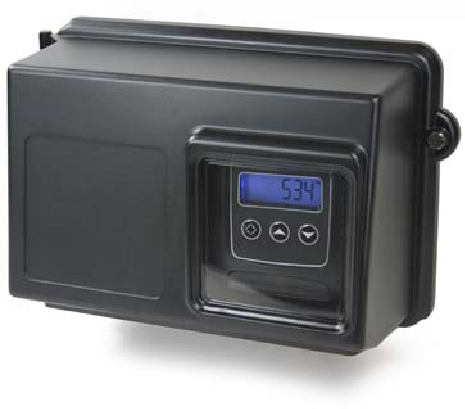 |
Pure Water Products offers the most complete selection of aeration equipment for iron and hydrogen sulfide treatment on the internet. The mighty AerMax, a pump-powered high performer with many options, has long been our main aeration product, but we also have less expensive venturi-driven units for less challenging iron/sulfide problems. Finally, we're improving and expanding our offerings in the passive aeration, single tank systems (control valve pictured above) that we initially sold with the manufacturer's name, the Eliminator. This is now a product in search of a name, so if you have a suggestion, let us know. |
Mexico’s Addiction to Costly Bottled Water Can Be Blamed on Government’s Failure to Provide and the Slick Ads of Multinationals.
Mexicans Are the World's Top Consumers of Bottled Water.
 |
|---|
| Multinationals’ bottled water ads promise health, happiness, and a slender figure. |
Tourists in Mexico take for granted that you can’t drink the tap water. Mexicans themselves are to an increasing degree of the same opinion.
Mexicans drink more bottled water than the citizens of any other country do, an average of 61.8 gallons per person each year, according to the Beverage Marketing Corp., a consultancy. That’s far higher than Italy, and more than twice as much as in the United States.
Part of the mistrust for tap water and the thirst for bottled water is fueled by clever advertising campaigns sponsored by multinational corporations. The Mexican government is also at fault for failing to sell tap water convincingly. Especially needed is credible evidence of water safety. National Geographic says, “High bottled water use [in Mexico] is a symptom of a failure of the government to provide.”
Now public drinking fountains in Mexico are as rare as pay phones in the United States. Unfortunately, the plastic bottle has become the standard delivery method for water as well as for soft drinks. Empty plastic water bottles litter landfills and roadsides at a rate that alarms consumer and environmental groups. Recycling experts say that only about one-eighth of the 21.3 million plastic water and soft drink bottles that are emptied each day in Mexico get recycled.
Many municipal water systems, which weren’t wonderful to begin with, have fallen into disrepair. Mexico City, for example, has not really restored its water system after the great 1985 earthquake which killed 10,000 people and destroyed many water mains. The city siphons water from the underlying aquifer faster than rainfall can replenish it, causing the city, much of which is built on an ancient lake bed, to sink, putting additional stress on leaky water mains. Some 30 percent of the city’s water is lost to leakage.
The ads are effective. Mexicans are second only the US in soft drink consumption, but they lead the US in bottled water consumption, with sales increasing at the rate of 8% per year. Ads encourage Mexicans to give the bottled water companies the trust that they don’t have in their government. Bottled water is ubiquitous. On street corners, vendors hawk liter bottles of water. Restaurants don’t offer tap water, insisting that diners buy bottled water. Primary school students must take money to buy bottled water from kiosks. One brand uses characters from Looney Toons to appeal to the student market.
The cost of bottled water is high. The average Mexican family spends about $140 a year on bottled water, much of it in 5-gallon plastic jugs that are commonly delivered to homes. The expense puts a heavy burden on low-income families. In impoverished neighborhoods in the outskirts of Mexico City, scores of private water companies have popped up, offering large jugs of water for 10 pesos, or about 77 U.S. cents, a third of the price of water from the multinational companies. Such concerns face few inspections, giving consumers water of indeterminate quality.
Early October Water News
The Pure Water Gazette features its pick of the top water news story each day. Here's what you missed in the first half of October if you haven't been reading the Gazette:
The new Gazette format also indexes much of the significant content of the old online and paper versions of the Pure Water Gazette. Take some time to browse. As our ad says, "Vast piles of information in the Gazette's tangy, irreverent style."
Daily water news items are designed to present a concise version of an important water issue with a reference link to more information if you care to pursue it.
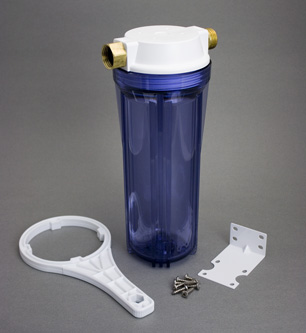 |
|---|
The Garden Hose Filter is an inexpensive and versatile item. We have garden hose filters in four sizes (the clear unit pictured above is the smallest) and with many cartridge options. Here are some places to look on our main website: Garden Hose Filters (Standard Size, like the one above). Does Soft Water Assure A Spot-Free Car Wash? |
B. Bea Sharper
Gazette Numerical Wizard B. Bee Sharper Reveals the Numerical Facts About This Issue, to See If You've Been Paying Attention |
 |
|---|
Percentage of antibiotics that can be removed from water by reverse osmosis -- >90%.
Most common fitting size of the bottom fitting on a flexible undersink faucet riser -- 3/8".
Amount Jackson, Mississippi will have to spend on sewage system improvements as per its agreement with EPA -- $400 million.
Number of softball-sized eyeballs found on a Florida beach in early October -- 1.
Rank of Mexico among the world's bottled water consuming nations -- #1.
Average Mexican annual per capita bottled water consumption, in gallons -- 61.8.
Number of plastic soft drink and water bottles that are emptied daily in Mexico -- 21.2 million.
Fraction of these bottles that are recycled-- 1/8
Percentage of Mexico City's water that is lost to leakage-- 30%.
Percentage of Mexico's tap water that is potable, according to government estimates -- 85%.
Annual sales increase for bottled water in Mexico -- 8%.
Average annual family expenditure for bottled water in Mexico --$140.
Year of the great Mexican earthquake, which killed 10,000 people -- 1985.
Here are some sections on the Occasional's website that you will want to visit:
Links to Pages about Water and Water Treatment
New Products from Pure Water Products
Pure Water Annie's Glossary of Water Treatment Terms
The Pure Water Occasional is a project of Pure Water Products. Please visit our websites: Main Website: www.purewaterproducts.com This site features our full range of products, plus instructions, technical articles, product manuals, and more. The Occasional's Website: www.purewateroccasional.net. In addition to archiving back issues of the email Occasional, this site houses a sizeable section about water contaminants, a "how things work," series, a new products section, a glossary of water treatment terms, and, "much, much more." Other Pure Water Products Sites: www.purauv.com To contact us by phone, please call 940 382 3814.
|
|---|

